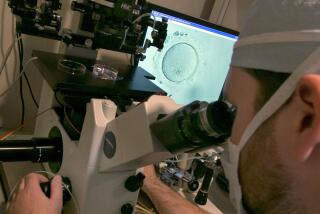Anencephalic Infants: Means to an End or Ends in Themselves? : No Life Should Be Traded for Another
Given our national commitment to the well-being of children, medical technology and last-minute rescues, it was instant news when Loma Linda University Medical Center announced that Baby Paul, a Canadian infant with a fatal heart defect, received a new heart removed from Baby Gabrielle, another Canadian child born without a skull and, largely, a brain.
Baby Paul, alive and relatively well, has left the hospital. One might think that only a Scrooge could raise questions as to the source of his beating heart. Yet the medical experiment involving Baby Paul raises profound legal, scientific and ethical questions that should not be avoided simply because we wish the best for Baby Paul and other babies in his situation.
Anencephaly, the medical term for Baby Gabrielle’s condition, occurs often enough (there are an estimated 2,000 to 3,000 such births each year in the United States) to create an attractive source of organs for infants and small children who need kidneys, hearts, livers and other body parts. There is a serious shortage of organs for such tiny patients.
Current law, however, requires that the patient be dead before the removal of organs essential for life. The death of patients on respirators is diagnosed by the irreversible cessation of all brain functions, including those of the brain stem (the part that regulates breathing and heartbeat). Babies with anencephaly who are born alive can breathe without a respirator because they have a functioning brain stem.
Conventional organ donors die from brain injuries due to accidents or to lack of oxygen to the brain. Because anencephalic babies suffer no similar kind of injury, it is difficult to understand what would injure their brain stems so as to satisfy brain-based criteria for death.
Although dying, these babies do not necessarily die immediately; they can live for days or, more infrequently, weeks or even months without aggressive treatment. They usually die from heart or lung failure --and that failure damages their organs, making them unusable for transplantation.
One way to gain access to these infants’ organs is to change the law determining death. By defining such babies as dead persons, their organs and tissues could be used immediately. Those who oppose this change argue that declaring an infant who is breathing without assistance “dead” would radically change our understanding of death. Second, changing the definition of death could undermine public confidence in physicians. If people feel that physicians are eager to declare a patient dead merely to obtain organs or tissue, then voluntary organ donation might be discouraged.
Furthermore, if the degree of brain damage is the basis for labeling such infants “dead,” then other groups of patients with functioning brain stems but who do not have the ability to think or interact could also be considered “dead” for the sake of obtaining their organs. This would include babies with other severe brain injuries, and both children and adults who are believed to be in a permanent coma or “vegetative state”--like the late Karen Quinlan. This might be particularly attractive to those who worry about the high financial and emotional costs involved in treating such patients.
Others argue that the law permitting organ donations by families should be changed to allow the parents of anencephalic newborns to make a gift of their living children’s organs, in order to assuage their grief and help other dying children. While clearly appealing on the surface, this suggestion raises the troubling question of the propriety of causing the death of these patients by removing their organs. Is it right for us to treat these children solely as a means to an end, even if the goal is otherwise good?
Arguing philosophically, some have claimed that anencephalic infants are “nonpersons” because they lack the upper portion of the brain necessary for normal brain function. Although there is much disagreement in our society about whether fetuses are “persons,” we have always held that a live-born infant is a “person.” To use brain function as a criterion for “personhood” would be a radical departure, especially when the determination of who is a “person” depends on who will benefit from his or her being made a “non-person.” Will those with advanced dementia or severe mental retardation also be killed as they were in Nazi Germany--except, in this case, it would be for their organs?
It is highly unlikely that these babies will meet the current legal and medical criteria of death while on respirators. Thus, treating dying anencephalic newborns in intensive-care units with respirators solely for the purpose of harvesting their organs is unjustified. The purpose of such treatment is not to help the infant; it is to keep the desired organs intact. Compassion for the parents certainly includes giving the information that under existing law they can authorize the removal of their children’s corneas, after death, for the benefit of other children. It should not include trading one life--however fleeting--for another.






